Dental implants can be dated back to civilizations as early as the Egyptians, Mayans, Phoenicians and the Hondurans. The first attempts of tooth transplants were made in Europe in the earlier part of 19th century. The 20th century saw the evolution of implant materials from gold to stainless steel to titanium.

Dr. Per Ingvar Branemark with his experiments in 1950s, revolutionized the way implants are seen today. With his detailed explanation of osseointegration, implants are a long lasting mode of treatment in not only dental but other medical conditions as well.
A dental implant is defined as a a component which is inserted surgically into bone to support future dental prosthesis such as bridge, denture, crown or as an orthodontic anchor.
Are dental implants a good choice?
If you have your doubts about implants, here are a few benefits you would like to consider:

-
They are fixed:
Unlike removable prosthesis such as complete and partial dentures that have to be removed at night and kept in a cup, implants stay in your mouth forever. Removable prosthesis also run the risk of slipping and falling out if not fabricated properly. Your implants have to be cared for just like the way you would care for your natural teeth.
-
Better speech:
Dental implants attach themselves in the mouth like natural teeth. This ideal positioning of teeth helps in proper articulation of speech with crystal clear words,
-
Healthy teeth protected:
If you go for fixed dental prosthesis (crowns, bridges), the teeth serving as abutments need to be reduced to a certain size to allow for the future crown/bridge to rest upon it. This means unnecessary loss of tooth structure to compensate for the missing tooth. However, no extra alterations are done on adjacent teeth while fixing implants.
-
Natural facial structure preserved:
It is said that soft tissues follow the contour of the hard tissues. The presence of teeth is an important factor in determining the contours of the face, lips and cheeks. Now a days people are using dental braces for correcting crooked or irregular teeth. Lack of teeth make the face look saggy and drooping whereas its presence; whether natural or artificial, shapes it up.
-
A long life:
Dental implants have this wonderful property of osseointegration, because of which the bone surrounding them grows and attaches to them. They remain fixed and if maintained properly can serve to last a lifetime.
-
Easier eating:
Dental implants function similar to your own teeth, with the added advantage that they won’t slide and make chewing difficult.
-
Better comfort:
Once the implant integrates into the bone, chewing food becomes a lot more easier with no discomfort as compared to other dental prosthesis.
-
Self-confidence restored:
Loss of teeth equals to loss of brightness in your smile. With stability, strength, comfort and aesthetics of the implant all rolled into one, you get a smile which shines through your personality.
What are the types of dental implants?
Implants can be categorized into various types, based on their design, shape, materials used, etc.
On the basis of design, we have:
1. Endosteal
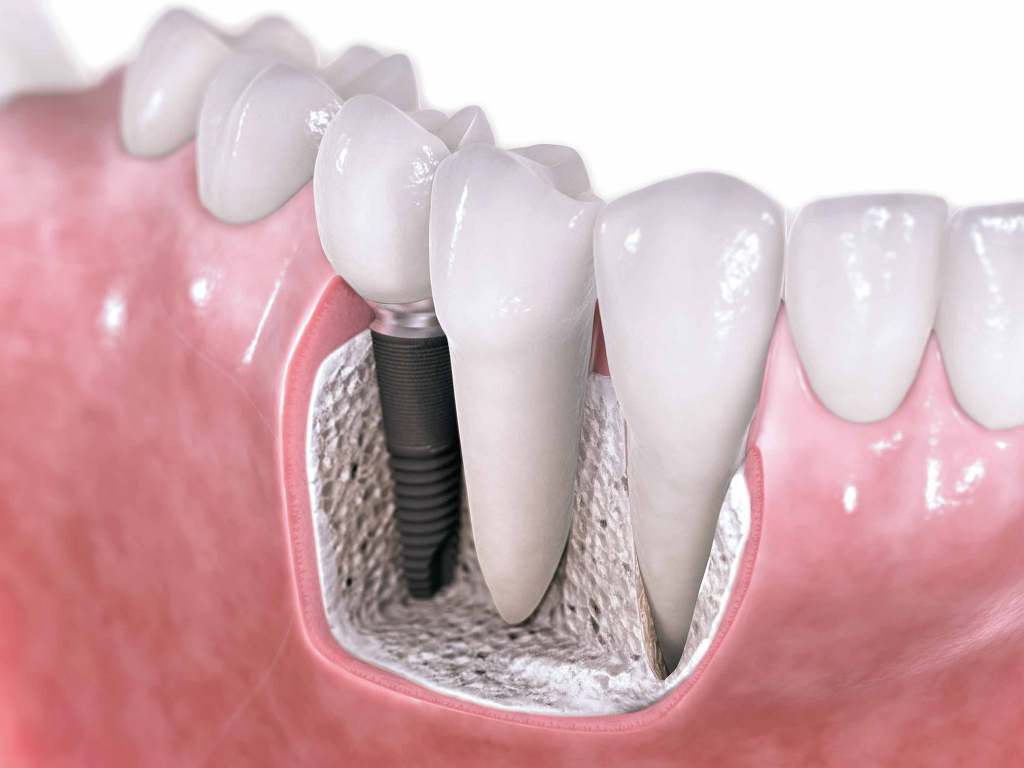
The implant is placed in the alveolar bone of either maxilla (upper jaw) or mandible (lower jaw) e.g. blade implants, ramus frame implants, root form, etc.
2. Subperiosteal
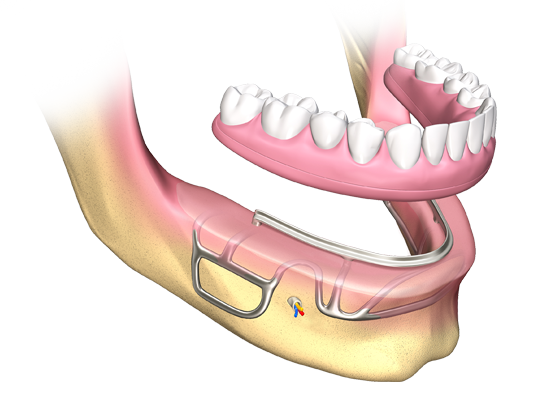
These implants don’t go inside the jaw bone directly, rather they are placed under the gum tissue, but still above the jaw bone.
3. Transosteal
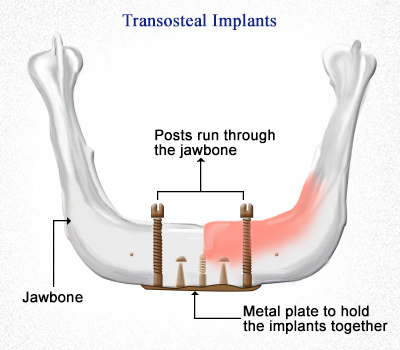
It combines both the endosteal and periosteal subtypes and can penetrate both cortical plates of jaw bone.
4. Intramucosal

It provides extra stability and retention, especially to dentures. These are inserted into the gums and act using a ‘push-button’ effect.
Implants today come in a variety of materials like:
- Titanium
- Poly-methyl methacrylate (PMMA)
- Carbon
- Silicon rubber
- Titanium alloys (Titanium + Aluminium + Vanadium)
- Aluminium oxide
- Cobalt-Chromium alloys
Now let us take a look into how these tiny strongholds look and work.
Parts of a dental implant :
A dental implant is constructed of three parts –
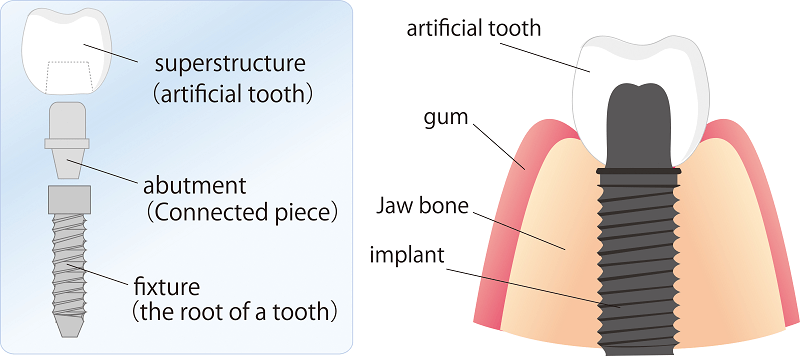
1. The implant fixture –
This part can be similar to the ‘root’ of a tooth. It lies below the gum line and fuses with the alveolar bone with time.
Titanium is the material of choice when it comes to implants. It can either be commercially pure titanium (99.5% pure) or titanium alloy (a mixture of aluminium & vanadium), which improves fracture resistance and strength.
Different designs impart the dental implant with better anchorage and stress bearing ability, such as threaded, cylindrical, hollow or solid.
Some implants instead of being smooth are grit-blasted, machine or chemically etched, to increase their roughness at a microscopic level. This helps the bone to grow into these spaces.
Surface treated implants are sprayed with a coating of hydroxyapatite which stimulates bone formation.
2. Implant Abutment –
This is the part where the future prosthesis will sit. It lies above the gum line and typically is ‘screw-like’ which is capped on the implant after it successfully integrates with bone.
3. Dental Prosthesis –
The component (crown, bridge, denture) which is fixed on the abutment and will out its function in the oral cavity.
How do implants work?
In order to attach themselves and stabilise in the jaw bone, implants may use any one of the two mechanisms :
-
Osseointegration:
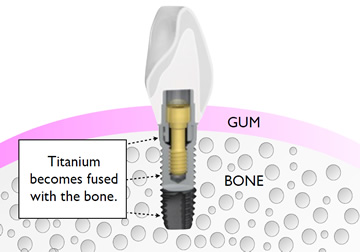
A term coined by Dr. Branemark, osseointegration means ‘connected/integrated with bone.’ The alveolar (jaw) bone anchors itself to the implant surface in such a way that a direct structural and functional relationship is established between the two surfaces (bone & implant), helping in appropriate distribution of the load exerted on the prosthetic tooth/teeth.
-
Fibrointegration:

This concept was introduced by Dr. Weiss. Unlike osseointegration where the bone grows directly into implant surface, here a layer of fibrous tissue is formed between the implant surface and alveolar bone. In a way, this fibrous tissue is similar to the periodontal ligament (a hammock like structure that supports the tooth inside the jaw) but without its shock absorbing ability.
Am I a likely candidate for dental implant?
Here is a list of situations where the placement of dental implant is indicated:
In cases where removable prosthesis cannot be tolerated e.g., a removable denture
When the aesthetic and/or functional demands are high
In complete edentulism (no teeth in the oral cavity), implant overdentures (a type of complete denture) offer a snug fit in the mouth with their ‘press studs’ effect
In some cases of partial edentulism, where only a few teeth are missing
When bridges (fixed partial dentures) are difficult to design because of lack of supporting teeth
Single tooth replacement
Under normal circumstances, almost any healthy individual is fit to receive a dental implant, but there may be some instances where your dentist may think twice before giving you the go-ahead:
Absolute contraindications:
Under any circumstances, implant treatment is deferred from:
- Cancer
- Bone diseases such as Paget’s disease, osteomalacia, brittle bones, osteoporosis, etc.
- Certain mental conditions
- Immunocompromised conditions, such as AIDS
- Heart diseases, placement of prosthetic valves, cardiomyopathy, heart attack, etc.
- If undergoing radiotherapy for cancer
- If prescribed on bisphosphonate drugs
Relative contraindications:
With appropriate control and treatment of the condition, implant placement is possible.
- Diabetes mellitus
- Epilepsy (abnormal electrical activity of the brain, causing seizures)
- High tobacco consumption
- Pregnancy
- Auto-immune diseases (e.g. Systemic Lupus Erythematosus)
- Angina pectoris
Apart from the above factors, following conditions in the mouth at that point of time may affect the success of implants:
- Poor oral hygiene makes the mouth a breeding ground for bacteria.
- Habits such as bruxism (excessive grinding of teeth in the night) or bruxomania (grinding of teeth throughout the day)
- Inflammatory conditions of the oral cavity (mucositis or any other). These need to be treated first before an implant is placed.
- The height, width and quality of alveolar bone determine the viability of implant placement. It is important that an implant should have a healthy bone tissue surrounding it.
The abnormal positioning of maxillary sinus, inferior alveolar nerve and other delicate structures also affect implant placement.
How are implants placed?
Before you undergo an implant procedure, your dentist will evaluate your fitness levels by checking the cleanliness and hygiene of your mouth. It isn’t a short process, but a long one with good returns in the end. Here’s what will happen :
- A full mouth X-ray will be taken.
- After this, a plaster model will be made which resembles your mouth and teeth.
- The dentist will then study the X-rays and models and determine the condition of your jaws and teeth.
- A treatment plan will be formed where your dentist will guide you through the entire process. You can clarify any doubts you have.
- Along with this, you will be instructed on how to take care of your implants after the surgery.
-The placement of a dental implant is an outpatient procedure and done under local anesthesia, so you will be awake during the entire procedure.
- In the first sitting, your dentist will create a small space in your jawbone and place the titanium implant inside, then cover it up with small stitches. After this, you will be given a waiting period of 3-6 months during which the implant will slowly integrate itself with the bone.
- When your next appointment comes, a small healing cap with a cover screw over the implant, will be placed around, which your gums will adapt. Once this happens, this cover screw will be the seat of future prosthesis.
- On an average, it takes about 1-2 hours to complete an implant surgery but a slightly long time of 3-6 months to recover.
- Now that the implant has completely integrated with jaw bone, your dentist will take an impression of your mouth, record the way you bite using putty or wax and send the records in a dental laboratory.
-The new prosthesis will be secured on cover screw and fixed with the help of a dental cement such as GIC, zinc phosphate, etc.
- In some cases, when the required bone height and quality isn’t available, a sinus lift procedure (in upper back region of jaw) or ridge augmentation (mostly in lower jaw) is performed to gain bone as per need.
How to take care of a dental implant?
Dental implants are very much similar to our natural teeth, they deserve the same kind of love and care that we give to our own natural dentition. Here are a few things you can do to help your implants give serviceability over the years:
- Keep them clean and free from plaque by brushing twice daily. A soft brush or an electric brush is preferable.
- Use antimicrobial mouthwashes like chlorhexidine, listerine etc. minimum two times a day.
- You can use dental floss in the spaces between adjacent teeth and abutments at least twice a week.
- Take care of your teeth. Apart from floss, interdental brushes can be used to clean spaces between teeth, ensuring a healthy environment for them and the implant.
- Visit your dentist regularly every 3-6 months for a follow-up examination and cleaning of the teeth.
Are dental implants costly?
The cost of a dental implant is dependent on the material used, skill of your dental surgeon and prevailing market prices in the area. An implant can cost anywhere between INR 12,000 to as high as INR 1 lakh per implant. Though this option seems to be very pricey, payment options to suit your convenience are available such as equated monthly installment (EMI), financing and insurance. You can discuss these options with your dentist and chose the best one of you.
Dental implant, though involving a surgical approach, is a conservative treatment option in the long run because it stimulates new bone growth and reduces the need to alter any adjacent teeth. With a success rate of 98% and judicious home care, implants are a long term solution to a healthy and great smile.